Thanks to recent trends, you could trip and fall in the lap of a decent quality laptop, but that doesn’t exactly cut it for streaming. To make things worse, some gaming marketed laptops offer subpar performance and leave you needing to upgrade within a year.
When it comes to Twitch streaming, you need a laptop with a great GPU and CPU, decent baseline storage and memory, and a smart design for proper heat management.
You can zero in your needs even more based on whether you want a dedicated streaming laptop, an additional screen, or something to game and stream on simultaneously.
Before we explore options for every avenue, let’s highlight our best budget and top-tier streaming laptop recommendations.
Best Budget Laptop For Streaming
Lenovo IdeaPad Gaming 3
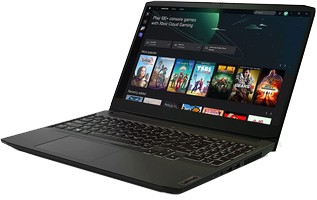
It’s hard to find a great budget streaming laptop, but the Lenovo IdeaPad Gaming 3 makes sure you have at least one. Its price puts it at competition with some desktops, and it can bring quick relief to those saving pennies for a streaming laptop.
While you don’t get the highest quality components, you’re not scraping the bottom of the barrel either. The IdeaPad Gaming 3 lets you sit comfortably without the pressure of upgrading anytime soon.
Best Laptop to Handle Gaming and Streaming
MSI GE76 Raider
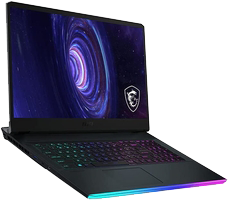
Not every laptop handles multitasking well, but it’s not something to worry about with the GE76 Raider from MSI. The company knows exactly what you need from a streaming laptop, and they certainly deliver.
We’ll expand on the exact details later, but this laptop is the better option if you want reliable high-quality performance without setting up a string of computers.
Top 6 Laptops for Streamers
A quick Amazon search easily returns over 3,000 results for “suitable” streaming laptops, but we’ve listed the top 6 options for you right here.
1. Acer Nitro 5 Laptop – Best Bang for Your Buck
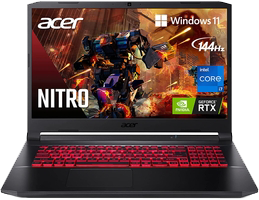 One of the best things you can do when buying a laptop for Twitch streaming is find one that respects both budget and capabilities.
One of the best things you can do when buying a laptop for Twitch streaming is find one that respects both budget and capabilities.
The Acer Nitro 5 is one of the most conscientious streaming laptops out there, and it’s well worth what you pay.
While the chassis isn’t what you would expect from gaming rigs in 2022, the Nitro 5 does its job well. It can tackle demanding tasks without complaint, and you can witness it all on one of the larger acceptable screen sizes.
Acer’s Killer DoubleShot Pro lets you use WiFi and an ethernet connection simultaneously while controlling traffic priority for maximum performance. Pair this with the tactile feedback from the keyboard, and it scratches quite a few itches.
| CPU | Intel Core i7-11800H |
| GPU | NVIDIA GeForce RTX 3050 |
| Storage | 1 TB SSD |
| RAM | 16 GB DDR4 |
| Display | 17.3 inches |
| Max Battery Life | ~8 Hours |
| More Specs & Reviews | Read more |
Pros
- No bloatware
- Great multitasking
- Phenomenal color accuracy
- Large display
Cons
- Included SSD could be faster
- Too easy to fail to put charger in all the way
- Cannot program custom colors
2. Razer Blade 15 Advanced Gaming Laptop – Most Portable
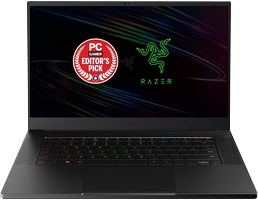 If you’re the type that wants a laptop strictly for streaming on the go, the Razer Blade 15 should be at the top of your list.
If you’re the type that wants a laptop strictly for streaming on the go, the Razer Blade 15 should be at the top of your list.
The 10th generation processor and stock RAM offer you plenty of multitasking power, and the 200 series GPU offers plenty of power without eating up your battery.
We appreciate the thin aluminum unibody frame of the Blade 15. Its durable construction keeps it lightweight and slim, perfect for a portable rig.
Those loyal to Razer peripherals will also appreciate native syncing from the Blade 15. On top of per-key chroma RGB lighting, you can link lighting effects, macros, and fan profiles using Razer Synapse 3 for an easy and outstanding setup.
| CPU | Intel Core i7-10875H |
| GPU | NVIDIA GeForce RTX 2070 |
| Storage | 512 GB SSD |
| RAM | 16 GB DDR4 |
| Display | 15.6 inches |
| Max Battery Life | ~7 Hours |
| More Specs & Reviews | Read more |
Pros
- Highly responsible trackpad
- Thin and compact for portability
- Zero bloatware
Cons
- Heats up with more intense programs
- Heavier weight
- Subpar keyboard (combined with heating performance)
3. ASUS TUF Dash 15 Laptop – Best WiFi
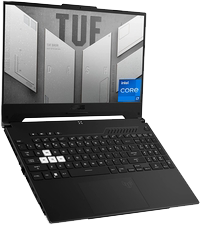 One of the downsides of laptops is how easily a single drop can take them out, but the ASUS TUF Dash 15 works to combat this.
One of the downsides of laptops is how easily a single drop can take them out, but the ASUS TUF Dash 15 works to combat this.
The design remains thin for proper portability, but, as part of the ASUS’s TUF line, it holds up well against drops, moisture, extreme temperatures, and vibrations.
The strength shows up on the inside as well. The Dash 15 features both DLSS and ray tracing, and a MUX switch connects the GPU directly to the display.
The i7 processor tackles pretty much anything you throw at it, and the Dash recharges in as little as one hour.
One of the best features is a pop-open screw for future memory and storage upgrades. While the included storage is at the bottom of acceptable, you won’t run into any issues when you swap or add storage and memory.
| CPU | Intel Core i7-12650H |
| GPU | NVIDIA GeForce RTX 3060 |
| Storage | 512 GB SSD |
| RAM | 16 GB DDR5 |
| Display | 15.6 inches |
| Max Battery Life | ~8 Hours |
| More Specs & Reviews | Read more |
Pros
- MIL-STD-819 military standard materials
- MUX switch improves latency and performance
- Quick charging
- Designed to stay clean and cool
Cons
- Fans loud under heavy loads
- Some bloatware
4. Lenovo IdeaPad Gaming 3 Laptop – Cheapest for Streaming
 Contrary to popular belief, you don’t need to sell an organ to start streaming. If you’re looking for a cheap laptop to get started to add to your toolset, the Lenovo IdeaPad Gaming 3 Laptop should suffice.
Contrary to popular belief, you don’t need to sell an organ to start streaming. If you’re looking for a cheap laptop to get started to add to your toolset, the Lenovo IdeaPad Gaming 3 Laptop should suffice.
While its processor and GPU are on the lower end, you’re still running newer generation hardware that’s perfectly capable of streaming and tackling intensive programs.
The IdeaPad Gaming 3 also manages to offer you a larger screen size and 96% keyboard without jacking up the price.
The matte screen finish works well in brighter settings, and the IdeaPad Gaming 3 runs cooler, faster, and quieter than its predecessors.
| CPU | AMD Ryzen 5 5600H |
| GPU | NVIDIA GeForce GTX 1650 |
| Storage | 256 GB SSD |
| RAM | 8 GB DDR4 |
| Display | 15.6 inches |
| Max Battery Life | ~8 Hours |
| More Specs & Reviews | Read more |
Pros
- Easy to upgrade storage and memory
- Lower cost and lighter weight
- Numpad (for those who like them)
Cons
- Minimum storage and memory means you’ll upgrade eventually
- Some bloatware
- Includes a Type-C port but not Type-C charging
5. ASUS ROG Strix Scar Laptop – Best CPU
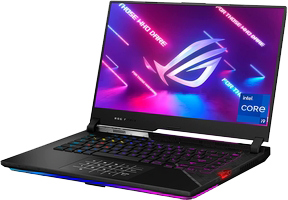 Your CPU does a lot of the heavy lifting when it comes to streaming, and the 12th generation i9 in the ASUS ROG Strix Scar is basically a professional bodybuilder.
Your CPU does a lot of the heavy lifting when it comes to streaming, and the 12th generation i9 in the ASUS ROG Strix Scar is basically a professional bodybuilder.
This processor features a total of 14 cores (6 performance and 8 efficient) that easily tear through the competition and sets you up for future high-performance upgrades.
Not that the ROG Strix Scar doesn’t already feature some of the most advanced technology for mobile gaming. Its GPU puts forth some of the most realistic ray tracing and AI features we’ve seen thanks to its MUX switch, and the included storage is both massive and fast.
This rig also works well for “can I customize it?” individuals. With an aura sync per key RGB keyboard and light bar, swappable armor caps, and ROG Keystone II, you can create unique and incredible presets to reflect the light inside.
| CPU | Intel Core i9-12900H |
| GPU | Nvidia GeForce RTX 3070 |
| Storage | 1 TB SSD |
| RAM | 16 GB DDR5 |
| Display | 15.6-inch FHD (2560 x 1440) |
| Max Battery Life | ~7 Hours |
| More Specs & Reviews | Read more |
Pros
- Great aesthetics
- Quiet cooling fans
- Dedicated macros keys
- Future-proof processors
Cons
- No webcam or biometrics
- Screen lacks brightness
- No SD card reader
- Support keyboard in touchpad isn’t a great replacement
6. MSI GE76 Raider Laptop – Best Money Can Buy
 Money doesn’t constitute a great setup, but investing in the MSI GE76 Raider sets you up for success. This is the rig for high performance, comfortability while streaming, and an overall “cool kid” feeling.
Money doesn’t constitute a great setup, but investing in the MSI GE76 Raider sets you up for success. This is the rig for high performance, comfortability while streaming, and an overall “cool kid” feeling.
Battery life isn’t great, but that’s because the GE75 Raider is putting all its energy into providing a quality experience. Considering the 17 inch screen, we really can’t complain.
The 11th generation i7 tackles pretty much anything you present without issue, and MSI’s Cooler Boost Technology uses large fans and heat pipes to optimize thermal dissipation of heat generated by this power.
Like the ROG Strix Scar, you can customize your keys as you see fit, and you can receive game status updates through your keyboard lighting. If you’re not big on customization, watching the lights respond to music is still a nice feature.
| CPU | Intel Core i7-11800H |
| GPU | NVIDIA GeForce RTX3080 |
| Storage | 1 TB SSD |
| RAM | 32 GB DDR4 |
| Display | 17.3 inches |
| Max Battery Life | ~6 Hours |
| More Specs & Reviews | Read more |
Pros
- A great upgrade from its predecessor – smaller, lighter, and cooler
- Reliable performance
- The most unique and aesthetic design on this list
Cons
- Keyboard may feel small for some
- Dim screen in bright rooms
- RGB may be a bit much for those who don’t care for it
Twitch Streaming Requirements
While you can theoretically stream using most computers or even cell phones, you need something with enough power to encode your video before sending it to Twitch for broadcasting.
Twitch presents several hardware recommendations to get you started, but you need the right software and settings to push out a high-quality stream.
Hardware Requirements
Your streaming device should have:
- A 4 core (ideally 6 core) processor or better
- A dedicated GPU
- 8 GB of RAM or more
We’ll touch more on these later, but understand that you need enough power to encode your video while live streaming. The encoding process eats up a good chunk of your processing power, and a laptop without a GPU or with a slower processor may not perform as expected.
Consider what hardware is included with your laptop and whether it pushes out high quality products. You may need to purchase additional hardware or peripherals for your stream, including:
- A USB interface or mixer
- A better quality microphone
- A higher quality webcam or high-end streaming camera
- Lighting
While this may seem complicated, there are several guides like this one to help you find the right tools for streaming.
Software Requirements
Streaming on Twitch goes beyond playing a game and logging in. Once you’ve established a proper internet connection (at least 3Mbps ideally via ethernet connection), you use streaming software to gather all your information and convert it to a suitable format.
Some of the most popular options include:
Twitch also has its own streaming software in beta right now that aims to be an all-in-one and seamless solution.
Pros and Cons of Using a Laptop for Streaming
On the plus side, laptops are much more mobile than desktops and they keep everything together in one place. It’s much easier to connect to the internet on the go with a laptop, so they’re perfect for streaming in more obscure areas.
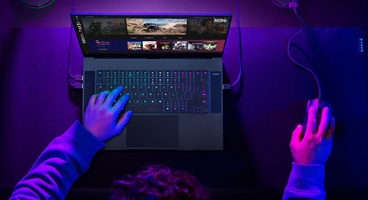 Laptops take up much less space than a desktop, and you can always put them away if you need to use the area for something other than streaming.
Laptops take up much less space than a desktop, and you can always put them away if you need to use the area for something other than streaming.
They also work well as a second screen if you don’t want to tax your existing system more and want something more versatile.
The budget-friendliness of a laptop depends on your situation. If you can only purchase one computer for streaming but need something you can take with you to class or work, a laptop is usually the better bet.
Laptops usually cost more than desktops with comparable features, and they aren’t as future-proof. Upgrading your CPU or GPU is usually a no-go, so you’ll need to upgrade your entire laptop to keep up with current technology.
Laptops, even those with the same processors as their desktop cousins, have handicapped performance. The processors optimized for a laptop are smaller and heat up easier, and they won’t reach the same heights as full-size components.
How to Choose the Right Laptop for Streaming on Twitch
When choosing the right laptop for streaming on Twitch, first verify the strength of components such as the processor and graphics card. Make sure these are at least on-par with current requirements, but aim for top of the line components in these areas.
You should also look at details such as the laptop’s display, storage and memory, and what special features it brings to the table. You should also decide on which peripherals you need to purchase to compensate for subpar features, as this affects your budget in the end.
Processor (CPU)
 Because you cannot upgrade your processor, it’s essential that you pick the highest-quality option available to you. Your processor performance affects stream quality and your laptop’s ability to encode and put out media.
Because you cannot upgrade your processor, it’s essential that you pick the highest-quality option available to you. Your processor performance affects stream quality and your laptop’s ability to encode and put out media.
Whether you choose an Intel or AMD processor, Twitch recommends something with at least 4 or 6 cores (the more the better). You can start with an Intel i5 (9th generation) or i7 (8th generation) or better. For AMD, look for Ryzen 5 or Ryzen 7 series.
Graphics Card (GPU)
You want a laptop with a dedicated graphics card for streaming, if only to share the encoding burden with your CPU. Because these aren’t easily upgraded, you should aim for the best GPU available in your budget.
Manufacturers like NVIDIA and AMD make mobile graphics cards to give your laptop the boost it needs for gaming and streaming. Make sure whatever you choose is sufficient to run your intended programs and give you some room for growth in the power department.
Most regard NVIDIA GPUs like the RTX 3060, GTX 1650, or MX450 as the best options for laptop streaming.
Display
 The display doesn’t do much to affect your stream quality, but it impacts how you feel about your laptop. Like a desktop monitor, you want at least 1080p with a 60Hz refresh rate for your display.
The display doesn’t do much to affect your stream quality, but it impacts how you feel about your laptop. Like a desktop monitor, you want at least 1080p with a 60Hz refresh rate for your display.
Pay attention to laptop size as well. Larger laptops may have poorer battery life and cost more, but the larger screen is much easier on the eyes.
Alternatively, you can connect your laptop to an external monitor when available.
Storage and Memory
While your storage and memory is easy to upgrade, it’s better to start with options suitable to your needs.
Make sure your laptop has enough storage to accommodate all your games and software. A 256 GB SSD might work fine for streaming on Twitch, but it doesn’t give you much room. We recommend at least a 512 GB SSD with a hard drive when starting out.
Your memory (RAM) also affects stream quality and computer performance. While streaming, you’re handling multiple programs at once, and you need at least 8 GB of RAM to tackle all these tasks simultaneously.
Pay attention to the RAM series you’re working with (i.e. DDR, DDR3, or DDR4) and what the laptop’s maximum RAM capacity is. You can always add more and swap out RAM in the future, but only up to the upper limit of your laptop.
Features and Extra Peripherals
Most laptops come with the basic features that you need, such as:
- Integrated webcams
- Extra USB ports
- Display ports
Pay attention to what features your laptop puts forth and what you might need to upgrade. For example, the webcam on most laptops is subpar and you should budget for a better option regardless.
Other things to consider are whether there are enough USB ports for your peripherals, whether you need adapters for certain items (i.e. a USB-to-ethernet adapter for laptops without an appropriate jack), and whether you can afford these additional items after purchasing your laptop.
FAQs
Can You Use a Laptop to Stream on Twitch?
You can use a laptop to stream on Twitch. You should make sure that your laptop meets the minimum requirements for Twitch streaming and find complementary peripherals to improve your stream, but a laptop is a great streaming tool for smaller or mobile streaming setups.
What Type of Laptop Do I Need to Stream on Twitch?
You need a laptop with a dedicated GPU and a strong processor (ideally 6 cores or more). Your processing units affect the laptop’s ability to encode your gameplay and video for high-quality streaming,
Which Laptop is the Best for Live Streaming?
Like most parts of your streaming setup, there’s no one-size-fits-all solution. Do some soul searching to learn what you expect from a laptop, then pick something that suits those specific needs.
Someone looking to do all their Twitch streaming from one machine will not have the same standards as someone looking for an additional streaming rig. You can save yourself a lot of grief by solidifying your needs before making that purchase.
If you’re still on the fence about what works best, you can’t go wrong with the ASUS ROG Strix Scar 15. It’s sitting at a nice price point, offers unparalleled performance, and sets you up well for future streaming needs.
WINNER




